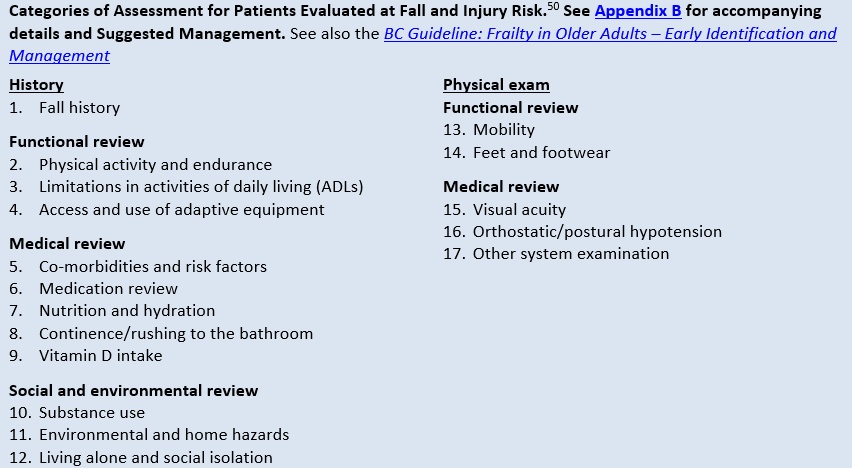The Definitive Guide to Dementia Fall Risk
Not known Incorrect Statements About Dementia Fall Risk
Table of ContentsDementia Fall Risk for BeginnersThe Dementia Fall Risk StatementsThe Ultimate Guide To Dementia Fall RiskA Biased View of Dementia Fall Risk
A loss risk assessment checks to see exactly how likely it is that you will certainly drop. It is mostly provided for older adults. The evaluation generally includes: This consists of a collection of questions regarding your total health and wellness and if you've had previous falls or problems with equilibrium, standing, and/or strolling. These devices evaluate your toughness, equilibrium, and stride (the method you stroll).Treatments are referrals that might reduce your danger of dropping. STEADI includes 3 steps: you for your risk of dropping for your threat variables that can be enhanced to try to avoid drops (for instance, equilibrium problems, impaired vision) to reduce your danger of falling by using effective techniques (for instance, supplying education and learning and sources), you may be asked numerous questions including: Have you dropped in the past year? Are you worried about dropping?
You'll sit down once more. Your company will check exactly how lengthy it takes you to do this. If it takes you 12 seconds or even more, it might mean you go to higher risk for an autumn. This test checks stamina and balance. You'll sit in a chair with your arms went across over your breast.
Relocate one foot halfway onward, so the instep is touching the huge toe of your other foot. Move one foot completely in front of the other, so the toes are touching the heel of your various other foot.
Dementia Fall Risk - Questions
A lot of falls occur as an outcome of multiple contributing factors; consequently, handling the risk of falling starts with determining the factors that add to drop danger - Dementia Fall Risk. A few of one of the most pertinent danger elements consist of: History of prior fallsChronic medical conditionsAcute illnessImpaired gait and balance, lower extremity weaknessCognitive impairmentChanges in visionCertain high-risk medicines and polypharmacyEnvironmental factors can additionally increase the threat for drops, consisting of: Poor lightingUneven or damaged flooringWet or slippery floorsMissing or harmed handrails and get barsDamaged or improperly equipped devices, such as beds, mobility devices, or walkersImproper usage of assistive devicesInadequate supervision of the individuals living in the NF, including those that exhibit aggressive behaviorsA effective fall threat administration program needs an extensive clinical evaluation, with input from all members of the interdisciplinary group

The care strategy must additionally include interventions that are system-based, such as those that promote a risk-free atmosphere (suitable lights, hand rails, get bars, etc). The effectiveness of the treatments ought to be assessed occasionally, and the care plan changed as needed to show adjustments in the fall risk evaluation. Applying an autumn threat monitoring system utilizing evidence-based ideal technique can lower the occurrence of drops in the NF, while restricting the possibility for fall-related injuries.
The 8-Second Trick For Dementia Fall Risk
The AGS/BGS guideline advises evaluating all adults aged 65 years and older for autumn risk annually. This screening consists of asking people whether they have actually fallen 2 or even more times in the past year or looked for clinical attention for an autumn, or, if they have not fallen, whether they really feel unsteady when strolling.
Individuals who have dropped when without injury needs to have their equilibrium and gait assessed; those with stride or balance irregularities need to receive extra evaluation. A background of 1 autumn without injury and without gait or equilibrium problems does not require additional analysis past ongoing yearly fall threat testing. Dementia pop over to this web-site Fall Risk. An autumn danger evaluation is needed as component of the Welcome to Medicare exam

9 Easy Facts About Dementia Fall Risk Shown
Recording a drops history is among the high quality indicators for fall prevention and administration. A crucial component of danger assessment is a medicine evaluation. Several courses of medicines boost autumn risk (Table 2). copyright drugs in certain are independent predictors of drops. These medications often tend to be sedating, modify the sensorium, and impair equilibrium and stride.
Postural hypotension can frequently be reduced by blog lowering the dose of blood pressurelowering medicines and/or stopping medications that have orthostatic hypotension as a side result. Use of above-the-knee support hose and sleeping with the head of the bed elevated may also lower postural decreases in blood pressure. The recommended components of a fall-focused health examination are received Box 1.

A TUG time greater than or equivalent to 12 secs suggests high loss threat. Being not able to stand up from a chair of knee elevation without utilizing one's arms suggests increased fall threat.